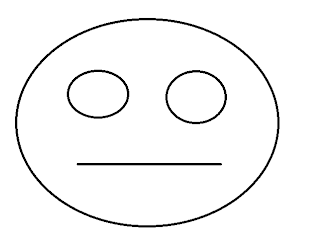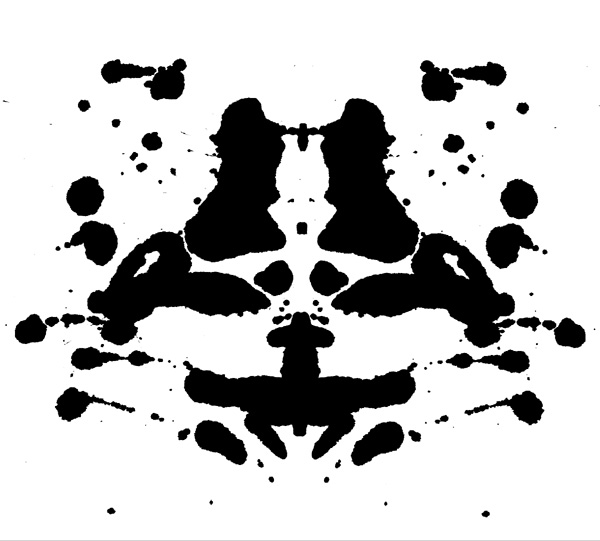and the reason behind seeing this face on the surface of Mars.1
and the reason why just about any circle with "eyes" and a "mouth" will look like a face, even if it is completely lacking in any real human features.
In fact, let's see how distorted that face can get before you no longer see it as a face.
still a face?
Maybe it looks a little alien, but still a face to me.
Even when I separated the eyes between the mouth it still looks like a face. I see it as two eyes and a long nose if I tilt my head to the right.2
Pareidolia is also what causes something random, like ink in the Rorschach tests, to look like something else.
|
|
| Oh, sorry. Wrong Rorschach. |
Your brain will attempt to interpret the random ink blots in the image above. Supposedly how you interpret the image gives insight into your psychological state, though there are good reasons not to believe that is the case.
The reason you see a face so easily in all of these examples is that you're brain has evolved (there's that pesky "E" word I keep bringing up) to quickly recognize faces. Carl Sagan hypothesized that the ability to recognize faces would be an important survival advantage for early humans. Being able to quickly identify a friend or foe could be the difference between life and death. This idea is related to the idea of a pattern-seeking mind that I have already talked about. The human brain is great at picking out patterns in random noise. Sometimes too good at it.
Related to pareidolia is the phenomenon known as sine wave speech. Matt Davis is a researcher at the MRC Cognition and Brain Sciences Unit. The following clips are from his website. Listen to this audio a few times. It should sound like (to quote my five year old) "a bunch of silly whistles". It may slightly resemble speech, and you may make out a few words, but for the most part it's nonsense (my five year old says he heard it say "I love you"). Now listen to this audio clip, and the original audio clip once more. Suddenly, with this new context, the first audio doesn't just sound like whistles and noise. Instead you can hear, almost clearly, a voice in the whistles. My five year old was able to quickly tell me what the voice was saying when he heard the whistles again. The shocked look on his face was priceless. He knew that his brain had just played a trick on him. I doubt you will hear it as only whistles ever again. Of course, this isn't quite the same as pareidolia. You don't need any perceptual insight to see a face on Mars or in a house. You just need millions of years of evolution to force your brain to see it that way.
Notes
[1] Just to be clear, that is not a sculpture from an ancient human-like civilization on Mars. It is a hill with rocks randomly strewn across it. Your brain interprets this randomness as a face. Higher resolution images have put this controversy to bed long ago - unless you're a conspiracy theorists, then it was all a big government cover up. Also, look behind you. They're watching you.
[2] After I had made this image, the first thing I did was tilt my head to the right. When I showed this to my brother he immediately tilted his head to the right. I wonder how many of you did the same thing. Your brain knew just where the face was, didn't it?
If you liked this article, head over and "like" our .











